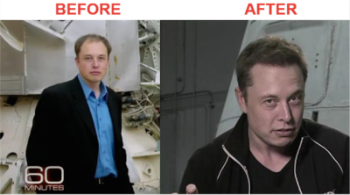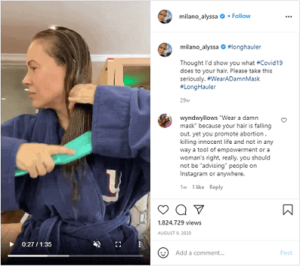Update: December 2021
A New Haircut for Elon Musk
Elon Musk (the world’s richest man, with a current net worth of $300 billion) and his hair surprise us yet again. This week, he made a much talked about appearance with a new haircut. It looks like Mr. Musk’s hair transplant has held up pretty well for all these years. Or perhaps he had more than one hair restoration procedure as is common?

The rear view in the above photo does not seem to indicate any major strip scar from a FUT hair transplant. Perhaps he got an FUE? Edit: A reader “Alex” pointed out two photos of Elon Musk showing what looks like a strip scar. In fact, one of the photos is from the new ones above, but closer up magnification.
It is also a possibility that Elon has a high-quality hairpiece. However, most doctors and surgeons seem to think that he definitely got a hair transplant procedure.
2017 Update: Almost two years after I wrote this post, Elon seemed to credit the “crown chakra” as helping him regrow his hair. Recent photos of him in 2018 suggest that Mr. Musk’s fuller hairline is still going strong. If you have enough money, you can reverse androgenetic alopecia (at least for a decade or two).
Dec 22, 2015

Elon Musk had a phenomenal 2015 and has been in the news virtually every week this year. His motor vehicle (Tesla) and solar power (SolarCity) companies continue to grow despite some turbulence. This week marked a new zenith to Mr. Musk’s fame after the successful SpaceX Falcon 9 rocket launching and booster landing.
Several weeks ago, Elon Musk, Peter Thiel (a fellow Paypal co-founders) and a number of other IT sector luminaries created a non-profit artificial intelligence (AI) research organization called OpenAI. It aims to develop AI while protecting mankind from rogue unfriendly AI led annihilation. While reading about that story, I came across a past photo from 2000 of Elon Musk’s hair (link to WSJ article with photo here).
Past Thinning Hair and Balding

Recently, I was quite shocked to see Elon Musk’s past thinning and receding hairline. I always see Mr. Musk with a full head of hair in all his recent photos.
In 2000 he was just 29 years old, which means that he probably started balding in his mid-20s or perhaps even earlier. You can see close-up balding images of Mr. Musk in this video from 1999.
Elon Musk’s Hair Transplant
The below is what Elon Musk looks like nowadays per a Gawker magazine/CBS before and after hair transplant photo.

I bet that he has had a hair transplant surgery procedure. Perhaps one day someone who interviews him will ask him which surgeon he went to for his hair transplant surgery?
Most likely, he went to a California based surgeon since he lives in the state for most of the year. The results are excellent and prove that as of 2015, hair restoration remains the best option we have to treat male pattern hair loss.
Joe Rogan
In 2018 and 2020, Elon Musk was interviewed twice by Joe Rogan. Those two interviews became the most watched videos ever on Mr. Rogan’s YouTube channel. Unfortunately, there was no discussion on how Elon regained his previously thinning hairline. I hope he divulges more information on this like other celebrities such as Ashton Kutcher.
